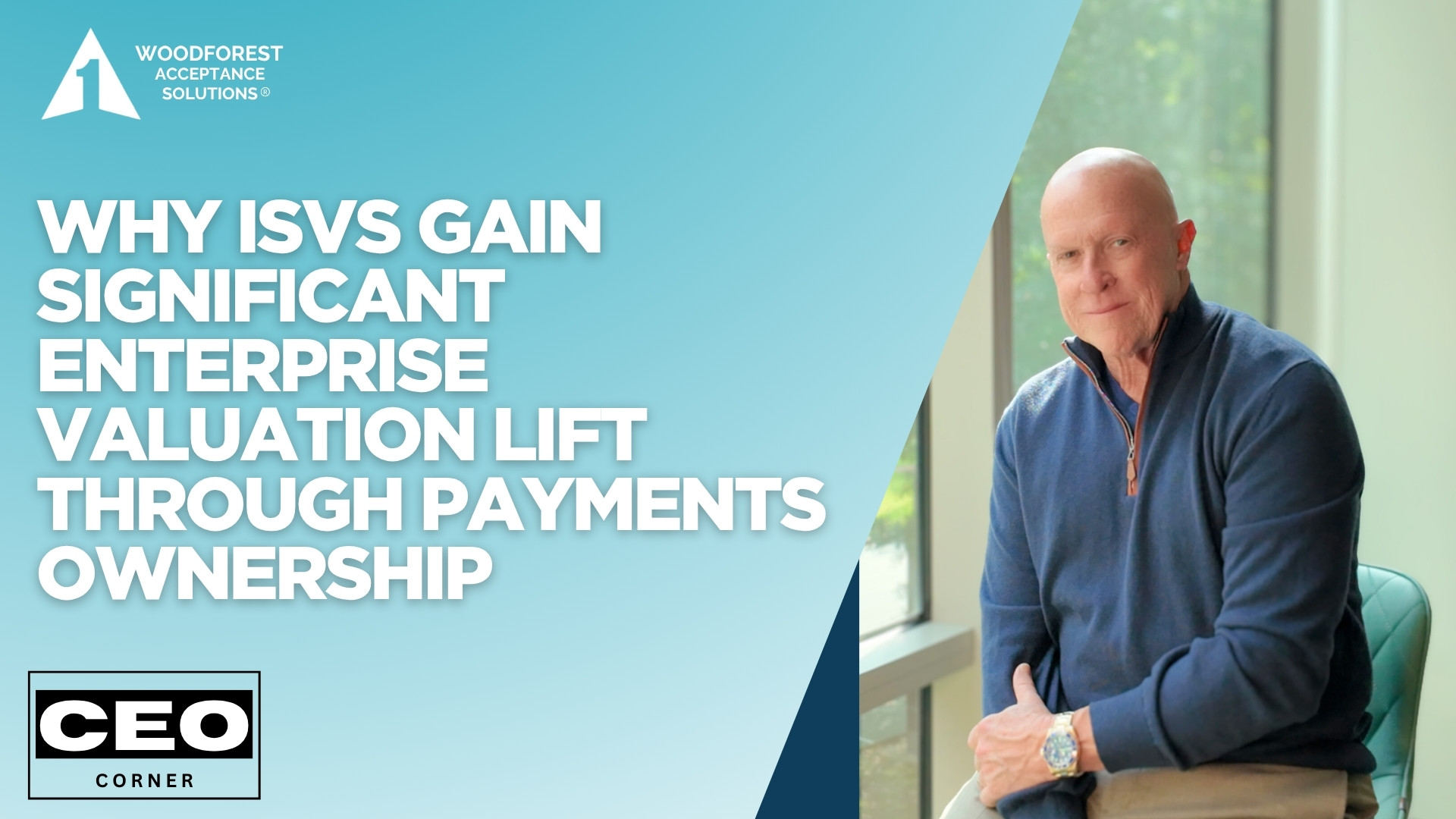Independent Software Vendors (ISVs) that own and control the electronic payments layer within their platforms experience a significant uplift in enterprise valuation. This stems from the ability to capture payment revenue, deepen customer relationships, and expand the scope of actionable data within their ecosystems.
Woodforest Acceptance Solutions (WAS) provides ISVs with a direct path to this payments ownership—without requiring them to assume payment risk, manage compliance infrastructure, or build out costly underwriting operations. Through WAS’s modernized acquiring platform that leverages switch-to-issuer technology, ISVs can participate directly in the economics and intelligence of the payment stream, accelerating both revenue and enterprise value creation.
1. Payments Ownership as a Valuation Catalyst
Enterprise valuations for ISVs are increasingly determined by their ability to embed financial services. Investors recognize that payment revenues represent high-margin, recurring income that scales directly with the ISV’s customer base.
When an ISV controls payments within its own platform:
- Revenue Expansion: Payments convert from a cost center to a profit stream.
- Customer Stickiness: Integrated payments reduce churn and strengthen software retention.
- Data Monetization: Payment data deepens insights into user behavior, supporting predictive analytics, cross-sell opportunities, and targeted marketing.
- Valuation Premium: Market transactions show that ISVs with embedded payments can command 2–5x higher revenue multiples compared to software-only peers.
However, traditional paths to this ownership—becoming a registered payment facilitator or acquirer—require major investments in compliance, risk, and underwriting infrastructure, introducing both financial and regulatory burdens.
2. The Woodforest Acceptance Solutions Path to Ownership
Woodforest Acceptance Solutions (WAS) redefines how ISVs achieve payments ownership. As a modernized merchant acquirer, WAS allows ISVs to participate in the full economics of payments while WAS assumes all regulatory, risk, and operational responsibilities.
Key Elements of the WAS Model
- Platform Pricing Contract: Enables the ISV to control the payment economics and customer relationships under a structured agreement.
- BIN Assignment Path: Upon achieving scale, the ISV can be assigned its own Bank Identification Number (BIN)—formalizing its ownership position while WAS continues to manage all risk, compliance, and underwriting functions.
- No Payment Liability: The ISV benefits from payment revenue and customer ownership without taking on credit or fraud exposure.
- Switch-to-Issuer Technology: WAS’s modernized platform routes transactions directly to card issuers, improving authorization rates, reducing interchange costs, and increasing transaction reliability.
3. Technical & Strategic Advantages
Beyond revenue participation, WAS’s infrastructure delivers tangible performance and data advantages for ISVs and their merchant customers:
- Optimized Authorization Routing: By connecting directly to issuers, WAS increases approval rates—driving higher merchant satisfaction and transaction volume.
- Payment Orchestration: Unified management of multiple payment methods and endpoints simplifies integrations and improves reliability.
- Advanced Data Access: ISVs and merchants gain visibility into transaction-level intelligence, supporting loyalty programs, customer analytics, and real-time decisioning.
- Seamless Integration: WAS’s API-driven architecture enables rapid embedding into existing ISV workflows and customer experiences.
4. Strategic Outcomes for ISVs
Through the WAS partnership, ISVs unlock a three-tiered value transformation:
- Economic Ownership – capture and scale payment processing revenue streams.
- Operational Efficiency – leverage WAS’s infrastructure and expertise to eliminate compliance, risk, and underwriting overhead.
- Data Intelligence – transform payments into a source of continuous business insight and merchant value creation.
The result is a platform that not only powers commerce but participates in it—a key driver of valuation multiples across the fintech and software sectors.
Conclusion
Owning the payments layer is no longer optional for leading ISVs—it is a strategic imperative. The ability to capture payment economics, strengthen customer retention, and monetize transaction data represents one of the most powerful levers of enterprise value creation in today’s software-driven economy.
Woodforest Acceptance Solutions delivers that ownership path—safely, efficiently, and without operational burden. Through WAS’s switch-to-issuer processing architecture, ISVs gain superior transaction performance, robust compliance coverage, and scalable payment economics—transforming their platforms from software solutions into financial ecosystems.
Written by Todd Linden, CEO of Woodforest Acceptance Solutions



